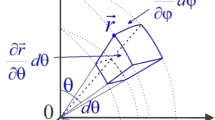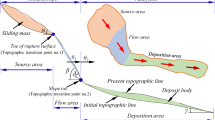Abstract
Rock avalanches often cause many casualties and considerable property damage due to hypermobility. To better understand the propagation process of rock avalanches, the mechanical energy evolution was investigated based on numerical simulation method and field investigation. Taking the well-known Jiweishan landslide as an example, the kinetic, potential, and dissipation energy elements were extracted from the kinematics parameters, and effective collisions were determined by calculating the local peaks of velocity. The lower velocity regions were observed in the middle portion of the sliding mass. Blocks in these regions were the medium through which the energy was transferred from the back portion of sliding mass to the front portion, acting like the stationary spheres in Newton’s Cradle. The entire sliding mass followed the law of conservation of energy, while the energy evolution of the individual blocks varied by their locations. Considering that more collisions occurred in the front portion of the sliding mass, blocks in this area received more energy during propagation, thus they traveled a longer distance. Furthermore, the energy transfer became more obvious with the increase in the volume of sliding mass, causing a larger travel distance for the rock avalanche.
















Similar content being viewed by others
Availability of data and material
The data and materials that support the findings of this study are available from the first and corresponding author, Yunfeng Ge, upon reasonable request.
Code availability
The codes that support the findings of this study are available from the first and corresponding author, Yunfeng Ge, upon reasonable request.
References
Campbell CS, Cleary PW, Hopkins M (1995) Large-scale landslide simulations: Global deformation, velocities and basal friction. J Geophys Res Solid Earth 100(B5):8267–8283
Cleary PW, Campbell CS (1993) Self-lubrication for long runout landslides: Examination by computer simulation. J Geophys Res Solid Earth 98(B12):21911–21924
Crosta GB, Imposimato S, Roddeman D (2015) Granul flows on erodible and non erodible inclines. Granul Matter 17(5):667–685
Davies TR (1982) Spreading of rock avalanche debris by mechanical fluidization. Rock Mech 15(1):9–24
Davies TR, McSaveney MJ, Hodgson KA (1999) A fragmentation-spreading model for long-runout rock avalanches. Can Geotech J 36(6):1096–1110
Davies TR, Reznichenko NV, McSaveney MJ (2020) Energy budget for a rock avalanche: fate of fracture-surface energy. Landslides 17(1):3–13
Donahue CM, Hrenya CM, Davis RH (2010) Stokes’s cradle: Newton’s cradle with liquid coating. Physical review letters 105(3):034501
Dufresne A (2012) Granular flow experiments on the interaction with stationary runout path materials and comparison to rock avalanche events. Earth Surf Proc Land 37(14):1527–1541
Eisbacher GH (1979) Cliff collapse and rock avalanches (sturzstroms) in the Mackenzie Mountains, northwestern Canada. Can Geotech J 16(2):309–334
Erismann TH (1979) Mechanisms of Large Landslides Rock Mechanics 12(1):15–46
Farmer J, Saville MA (2015) Effects of local peak detection on attributed scattering centre extraction in SAR. Electron Lett 51(8):646–648
Federico F, Cesali C (2015) An energy-based approach to predict debris flow mobility and analyze empirical relationships. Can Geotech J 52(12):2113–2133
Gassen WV, Cruden DM (1990) Momentum transfer and friction in the debris of rock avalanches: Reply. Can Geotech J 27(5):698–699
Ge YF, Tang HM, Eldin MAME, Chen HZ, Zhong P, Zhang L, Fang K (2019) Deposit characteristics of the Jiweishan rapid long-runout landslide based on field investigation and numerical modeling. Bull Eng Geol Env 78(6):4383–4396
Ge YF, Zhou T, Tang HM, Lin ZS (2020) Influence of the impact angle on the motion and deposition of granular flows. Eng Geol 275:105746
Goguel J. (1978). Scale-dependent rockslide mechanisms, with emphasis on the role of pore fluid vaporization. In Developments in geotechnical engineering (Vol. 14, pp. 693–705). Elsevier
Hsü KJ (1975) Catastrophic debris streams (sturzstroms) generated by rockfalls. Geol Soc Am Bull 86(1):129–140
Hu W, Huang R, McSaveney M, Yao L, Xu Q, Feng M, Zhang X (2019) Superheated steam, hot CO2 and dynamic recrystallization from frictional heat jointly lubricated a giant landslide: field and experimental evidence. Earth Planet Sci Lett 510:85–93
Itasca Consulting Group Inc. (2007) User’s Guide of 3DEC Version 4.1, pp. 1–22. Minneapolis: Itasca Consulting Group Inc.
Kent PE (1966) The transport mechanism in catastrophic rock falls. J Geol 74(1):79–83
Kulatilake PH, Ge Y (2014) Investigation of stability of the critical rock blocks that initiated the Jiweishan landslide in China. Geotech Geol Eng 32(5):1291–1315
Kulatilake PHSW, Wathugala DN, Stephansson O (1993) Joint network modelling with a validation exercise in Stripa mine, Sweden. Int J Rock Mech Min Sci Geomech Abstr 30(5):503–526
Legros F (2002) The mobility of long-runout landslides. Eng Geol 63(3–4):301–331
Li C, Fu Z, Wang Y, Tang H, Yan J, Gong W, Criss RE (2019) Susceptibility of reservoir-induced landslides and strategies for increasing the slope stability in the Three Gorges Reservoir Area: Zigui Basin as an example. Eng Geol 261:105279
Li Z, Huang X, Xu Q, Yu D, Fan J, Qiao X (2017) Dynamics of the Wulong landslide revealed by broadband seismic records. Earth Planets Space 69(1):1–10
Lucas A, Mangeney A, Ampuero JP (2014) Frictional velocity-weakening in landslides on Earth and on other planetary bodies. Nat Commun 5(1):1–9
Melosh HJ (1996) Dynamical weakening of faults by acoustic fluidization. Nature 379(6566):601–606
Mollon G, Richefeu V, Villard P, Daudon D (2012) Numerical simulation of rock avalanches: Influence of a local dissipative contact model on the collective behavior of granular flows. J Geophys Res Earth Surf 117:F02036
Okura Y, Kitahara H, Sammori T, Kawanami A (2000) The effects of rockfall volume on runout distance. Eng Geol 58(2):109–124
Sassa K (1989) Geotechnical model for the motion of landslides (Special lecture). In Proc. 5th Inter. Symp on Landslide 1:37–56
Shreve RL (1968) Leakage and fluidization in air-layer lubricated avalanches. Geol Soc Am Bull 79(5):653–658
Tang H, Wasowski J, Juang CH (2019) Geohazards in the three Gorges Reservoir Area China–lessons learned from decades of research. Eng Geol 261:105267
Voight B, Janda RJ, Glicken H, Douglass PM (1983) Nature and mechanics of the Mount St Helens rockslide-avalanche of 18 May 1980. Geotechnique 33(3):243–273
Voight B, Sousa J (1994) Lessons from Ontake-san: a comparative analysis of debris avalanche dynamics. Eng Geol 38(3–4):261–297
Weidinger JT, Korup O (2009) Frictionite as evidence for a large Late Quaternary rockslide near Kanchenjunga, Sikkim Himalayas, India—implications for extreme events in mountain relief destruction. Geomorphology 103(1):57–65
**ng A, Yuan X, Xu Q, Zhao Q, Huang H, Cheng Q (2017) Characteristics and numerical runout modelling of a catastrophic rock avalanche triggered by the Wenchuan earthquake in the Wenjia valley, Mianzhu, Sichuan. China Landslides 14(1):83–98
Xu Q, Fan X, Huang R, Yin Y, Hou S, Dong X, Tang M (2010) A catastrophic rockslide-debris flow in Wulong, Chongqing, China in 2009: background, characterization, and causes. Landslides 7(1):75–87
Yin Y, Sun P, Zhang M, Li B (2011) Mechanism on apparent dip sliding of oblique inclined bedding rockslide at Jiweishan, Chongqing. China Landslides 8(1):49–65
Yin Y, **ng A (2012) Aerodynamic modeling of the Yigong gigantic rock slide-debris avalanche, Tibet, China. Bull Eng Geol Env 71(1):149–160
Zhao T, Crosta GB, Utili S, De Blasio FV (2017) Investigation of rock fragmentation during rockfalls and rock avalanches via 3-D discrete element analyses. J Geophys Res Earth Surf 122(3):678–695
Zhao Z, Deng L (2020) Initiation mechanism of Jiweishan high-speed rockslide in Chongqing. China Natural Hazards 103(3):3765–3781
Acknowledgements
The authors are grateful to Mr. Ross Haselhorst and Mrs. Lea Hickerson in Missouri University of Science and Technology for language editing.
Funding
This work was supported by the National Key R&D Program of China (No. 2017YFC1501303 & 2018YFC1507200) and the National Natural Science Foundation of China (No. 42077264).
Author information
Authors and Affiliations
Contributions
Yunfeng Ge: conceptualization, data curation, formal analysis, investigation, methodology, resources, software, supervision, validation, visualization, and writing original draft. Huiming Tang: conceptualization, funding acquisition, project administration, and supervision. Changdong Li: data curation, software, visualization, project administration, and writing-original draft.
Corresponding author
Ethics declarations
Competing interests
The authors declare no competing interests.
Rights and permissions
About this article
Cite this article
Ge, Y., Tang, H. & Li, C. Mechanical energy evolution in the propagation of rock avalanches using field survey and numerical simulation. Landslides 18, 3559–3576 (2021). https://doi.org/10.1007/s10346-021-01750-1
Received:
Accepted:
Published:
Issue Date:
DOI: https://doi.org/10.1007/s10346-021-01750-1




